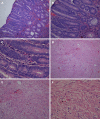Peutz-Jeghers syndrome with mesenteric fibromatosis: A case report and review of literature
- PMID: 32110669
- PMCID: PMC7031834
- DOI: 10.12998/wjcc.v8.i3.577
Peutz-Jeghers syndrome with mesenteric fibromatosis: A case report and review of literature
Abstract
Background: Peutz-Jeghers syndrome (PJS) and mesenteric fibromatosis (MF) are rare diseases, and PJS accompanying MF has not been previously reported. Here, we report a case of a 36-year-old man with both PJS and MF, who underwent total colectomy and MF surgical excision without regular follow-up. Two years later, he sought treatment for recurrent acute abdominal pain. Emergency computed tomography showed multiple soft tissue masses in the abdominal and pelvic cavity, and adhesions in the small bowel and peritoneum. Partial intestinal resection and excision of the recurrent MF were performed to relieve the symptoms.
Case summary: A 36-year-old male patient underwent total colectomy for PJS with MF. No regular reexamination was performed after the operation. Two years later, due to intestinal obstruction caused by MF enveloping part of the small intestine and peritoneum, the patient came to our hospital for treatment. Extensive recurrence was observed in the abdomen and pelvic cavity. The MF had invaded the small intestine and could not be relieved intraoperatively. Finally, partial bowel resection, proximal stoma, and intravenous nutrition were performed to maintain life.
Conclusion: Regular detection is the primary way to prevent deterioration from PJS. Although MF is a benign tumor, it has characteristics of invasive growth and ready recurrence. Therefore, close follow-up of both the history of MF and gastrointestinal surgery are advisable. Early detection and early treatment are the main means of improving patient prognosis.
Keywords: Case report; Mesenteric fibromatosis; Peutz-Jeghers syndrome; Recurrence; Regular follow-up.
©The Author(s) 2020. Published by Baishideng Publishing Group Inc. All rights reserved.
Conflict of interest statement
Conflict-of-interest statement: The authors declare that they have no conflicts of interest.
Figures






Similar articles
-
Peutz-Jeghers syndrome: an unusual cause of recurrent intussusception in a 7-year-old boy.Turk J Pediatr. 2016;58(5):535-537. doi: 10.24953/turkjped.2016.05.012. Turk J Pediatr. 2016. PMID: 28621096
-
Side-to-side bowel anastomosis mimicking intussusception in a 2-year-old child with Peutz-Jeghers syndrome.Radiol Case Rep. 2018 Jun 20;13(4):839-842. doi: 10.1016/j.radcr.2018.05.012. eCollection 2018 Aug. Radiol Case Rep. 2018. PMID: 29955242 Free PMC article.
-
Malignant tumors associated with Peutz-Jeghers syndrome: Five cases from a single surgical unit.World J Clin Cases. 2020 Jan 26;8(2):264-275. doi: 10.12998/wjcc.v8.i2.264. World J Clin Cases. 2020. PMID: 32047774 Free PMC article.
-
Extremely young case of small bowel intussusception due to Peutz-Jeghers syndrome with nonsense mutation of STK11.Clin J Gastroenterol. 2019 Oct;12(5):429-433. doi: 10.1007/s12328-019-00964-0. Epub 2019 Mar 19. Clin J Gastroenterol. 2019. PMID: 30888642 Review.
-
Extraintestinal polyps in Peutz-Jeghers syndrome: presentation of four cases and review of the literature. Deutsche Peutz-Jeghers-Studiengruppe.Int J Colorectal Dis. 2000 Apr;15(2):118-23. doi: 10.1007/s003840050245. Int J Colorectal Dis. 2000. PMID: 10855556 Review.
Cited by
-
A case of sporadic Peutz-Jeghers syndrome presenting as multiple intussusceptions.J Surg Case Rep. 2022 Mar 9;2022(3):rjac070. doi: 10.1093/jscr/rjac070. eCollection 2022 Mar. J Surg Case Rep. 2022. PMID: 35280052 Free PMC article.
-
Minimally Invasive Elective Surgery as a Treatment of Bowel Invagination in a Peutz-Jeghers Syndrome Case.Case Rep Gastroenterol. 2021 Jun 10;15(2):495-500. doi: 10.1159/000512423. eCollection 2021 May-Aug. Case Rep Gastroenterol. 2021. PMID: 34616246 Free PMC article.
-
Hamartomatous polyps: Diagnosis, surveillance, and management.World J Gastroenterol. 2023 Feb 28;29(8):1304-1314. doi: 10.3748/wjg.v29.i8.1304. World J Gastroenterol. 2023. PMID: 36925460 Free PMC article. Review.
-
Peutz-Jeghers syndrome presenting with jejunoileal intussusception in a pediatric patient: A rare case report, in a developing country, Gondar, Ethiopia.Int J Surg Case Rep. 2025 Sep;134:111715. doi: 10.1016/j.ijscr.2025.111715. Epub 2025 Jul 30. Int J Surg Case Rep. 2025. PMID: 40773929 Free PMC article.
References
-
- Daniell J, Plazzer JP, Perera A, Macrae F. An exploration of genotype-phenotype link between Peutz-Jeghers syndrome and STK11: a review. Fam Cancer. 2018;17:421–427. - PubMed
-
- Sakorafas GH, Nissotakis C, Peros G. Abdominal desmoid tumors. Surg Oncol. 2007;16:131–142. - PubMed
-
- Chaudhary P. Mesenteric fibromatosis. Int J Colorectal Dis. 2014;29:1445–1451. - PubMed
Publication types
LinkOut - more resources
Full Text Sources

